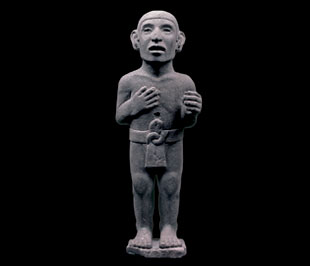|
























|
|









People in the Aztec World
In the art of the Aztec period, a significant category is sculptures and figurines that represent people. In fact, this is an identifying characteristic of artistic creations of the Late Postclassic period in the central Mexican highlands. These images of men and women express ideals in terms of both age and beauty. The young adult stage was considered to be a person's prime, guaranteeing strength in times of war. Because this age was also that of the greatest sexual activity, the sculptures represent the social paradigm that was so necessary for imperial supremacy.
The noteworthy development achieved by sculpture workshops in the main indigenous capitals, such as Mexico-Tenochtitlan, Tetzcoco, and Calixtlahuaca, left extraordinary figures sculpted in volcanic rock, the preferred material in the Aztec world. This exhibition features an idealized image of the common man, the macehual, and the female nude popularly known as the "Venus of Tetzcoco."
Macehual. Aztec, ca. 1500. Stone, 80 x 28 x 19 cm. Museo Nacional de Antropología, INAH, Mexico City. Photo Michel Zabé, assistant Enrique Macías.
|
|